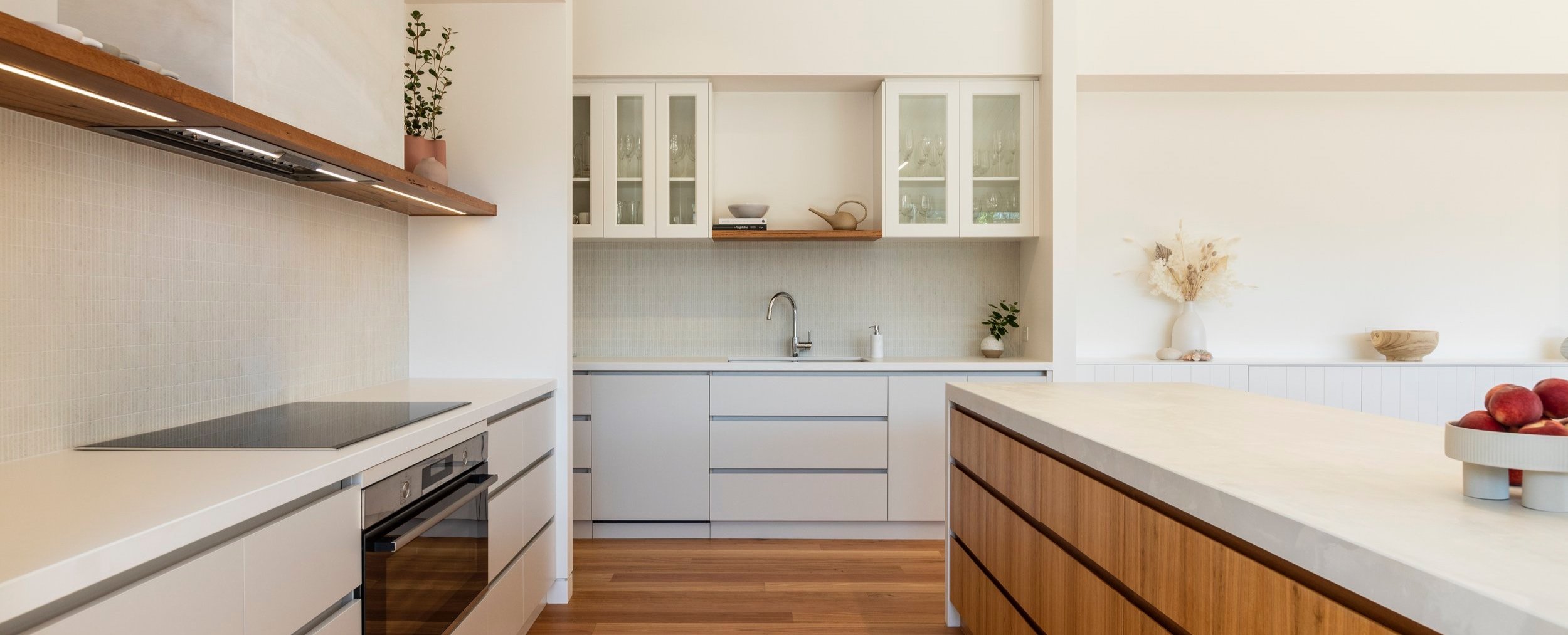Six Key Insights for Exceptional Kitchen Design: A Guide for Renovation and New Builds
Kitchens have significantly evolved from merely functional spaces for cooking. In contemporary households, they often serve as the vibrant epicentre of daily life, witnessing the hustle and bustle of family activities, from the crack of dawn to the close of the day. These dynamic spaces play host to multifaceted interactions - from parents preparing meals while assisting with homework, to friends congregating for pre-dinner cocktails and conversation, and in larger abodes, even functioning as an additional living area. Consequently, it's imperative to meticulously plan your kitchen design from the outset, ensuring it aligns perfectly with your lifestyle and household needs. Drawing from our extensive experience in crafting diverse kitchen spaces, we've established a set of essential design principles that guide every project we undertake.
1. Lifestyle: Tailoring Your Kitchen to Your Unique Way of Life
The functionality and layout of your kitchen are influenced by your lifestyle. If you enjoy cooking, consider expanding your bench space to accommodate food preparation and add a stylish rack for your pots and pans. For larger families, a spacious pantry is essential for storing family-sized groceries. If you frequently entertain guests, an open-plan kitchen that allows you to interact with your guests while preparing a culinary masterpiece would be ideal. Equally important are your reasons for renovating or building a new kitchen. Are you aiming to create a more efficient space or transform a tired old home with a stunning modern look? Consider whether these reasons may change in the future. As your lifestyle evolves, your kitchen should be adaptable to your needs.
A comprehensive brief proves invaluable when designing your dream kitchen. Ensuring that it addresses all relevant questions, gathers necessary information, and provides clear answers will crystallize your vision for your ideal kitchen. This thorough groundwork paves the way for a seamless decision-making process as your design journey unfolds.
2. Layout: The Art of Maximizing Flow
The layout of your kitchen plays a significant role in its functionality and flow. Achieving the perfect balance between aesthetics and practicality is crucial. An ideal kitchen layout not only enhances the overall dimensions of your home but also improves the efficiency of your cooking and entertaining experiences.
We prioritize strategic placements within the kitchen. For instance, we position the fridge in a convenient location, allowing family members to grab a drink without disrupting the working space. This simple yet thoughtful placement contributes to a more efficient and harmonious kitchen environment.
We also ensure that the sink is situated between the pull-out bins and the dishwasher, creating a centralized area for washing up. This arrangement streamlines the cleanup process and enhances the overall functionality of your kitchen.
While the age-old concept of the kitchen work triangle remains effective, we believe in exploring layout options beyond those limitations. Keeping the island bench clear often leads to a more efficient kitchen. The island becomes a versatile surface for food preparation, dining, and even entertaining.
Our goal is to create a kitchen layout that not only meets your aesthetic preferences but also maximizes functionality, making your kitchen a joy to work in every day.
3. Storage: Innovative Solutions for a Clutter-Free Kitchen
Efficient storage solutions are essential for maintaining a tidy and organized kitchen. They require careful planning and thoughtful design. It's not just about having enough space; it's about creating customized solutions that meet your specific needs. One common mistake in kitchen design is using generic storage options that don't cater to individual lifestyles, appliances, and cookware.
On the contrary, a well-designed kitchen incorporates a variety of storage structures, such as cabinets, shelves, and drawers of different sizes. For example, deep drawers are perfect for large pots and pans, while slimline under-bench storage is ideal for chopping boards. Integrated shelving can be used to display decorative items.
By prioritizing a well-planned layout and incorporating numerous drawers, you may find that upper cabinets become less necessary. This frees up wall space, allowing for a spacious and visually striking splashback. If possible, allocate an area for full-wall-height storage. This can house wall-mounted ovens, appliance cupboards, pantries, and integrated fridges. This approach creates a seamless and tidy aesthetic, while conveniently grouping essential items.
Lastly, don't underestimate the importance of a properly installed range hood. It's surprising how many kitchens have ineffective ducting, resulting in lingering cooking smells and grease. Ensuring that your rangehood is correctly installed and functional greatly enhances cleanliness and overall ambience in the kitchen.
By prioritizing efficient storage solutions, your kitchen will become a visually pleasing and highly functional space.
4. Sustainability: Eco-Friendly Choices for the Modern Kitchen
In today's world, sustainability should be at the forefront of all our decisions, and your kitchen design should be no exception. By consciously selecting eco-friendly materials and suppliers, you can significantly reduce your kitchen's environmental footprint. One way to achieve this is by repurposing or upcycling materials rather than resorting to demolition. Old cabinets and countertops can be refurbished or repurposed to bring a fresh and unique touch to your space while minimizing waste. Utilizing reclaimed wood, for instance, is a stylish and eco-friendly way to add a touch of warmth.
Choosing local suppliers not only supports the local economy but also reduces the carbon footprint associated with transporting materials from afar. Moreover, local suppliers often have a better understanding of the area's unique needs and constraints, thus can provide personalized solutions that align well with your project.
The health of your household should also be a top priority. Therefore, when selecting materials, it's important to consider their toxicity levels. Opt for low Volatile Organic Compound (VOC) paints, which have less harmful emissions than traditional paints. The use of engineered stones has also been linked to silicosis, a lung disease caused by inhaling silica dust. Therefore, when choosing countertops, opt for materials like sustainably harvested wood, recycled glass or natural stone and porcelain.
By making sustainable choices for your kitchen design, you're not only contributing to a healthier environment but also creating a healthier and safer space for your family. After all, the kitchen is the heart of the home, and what could be more important than ensuring it's both sustainable and safe?
5. Lighting: Illuminating Your Space for Ambiance and Efficiency
A common pitfall in many contemporary homes is the overuse of generic, glaring downlights, with the kitchen island often overly illuminated, resembling a restaurant servery. To truly elevate your kitchen design and optimize functionality, it's essential to strategically define areas for task and ambient lighting.
Task lighting should be carefully placed to ensure the greatest efficiency while avoiding the creation of shadows over workspaces. This might include under-cabinet lights that illuminate your food prep and cooking spaces while lighting over the island or dining area can provide both task and ambient lighting.
Ambient lighting, on the other hand, contributes to the overall atmosphere of the room. Being able to control the level of ambient light with a dimmer switch allows you to adjust the mood of the room depending on the time of day or event.
Incorporating separate circuits for every type of lighting ensures you have control over each light source, allowing you to alter the feel of the room at the flick of a switch.
Your choice of lighting fixtures should accentuate the style of your home, whether it leans more towards minimalist or maximalist design. Avoid getting swept up in fast-paced lighting trends; instead, opt for timeless pieces that suit your unique style and lifestyle. Remember, lighting is not just functional – it's also a representation of your distinctive aesthetic and should complement your kitchen's overall design.
6. Durability: The Importance of Long-Lasting Materials in Kitchen Design
When selecting materials for your kitchen design, durability should be a key consideration to ensure long-term value. High-quality, resilient materials can significantly reduce maintenance needs over the lifetime of your home, ultimately affecting the overall cost. For instance, opting for tap fittings with quality brass inserts rather than plastic mechanisms can prevent unexpected breakages, guaranteeing long-lasting performance and saving you money and frustration in the long run.
Thoughtful selection of materials also extends to bench tops and backsplashes. While tiled bench tops and busy backsplashes can add texture and visual interest to less utilized areas of the kitchen, they might not be the best choice for high-traffic areas. Especially if you're a spirited chef, it's crucial to ensure that your primary workspaces are easy to maintain and clean. Opting for materials that can endure high usage without losing their aesthetic appeal, such as porcelain panels or stainless steel for bench tops, will serve you well in the long run.
By carefully considering how each area and surface in your kitchen will be used, you can come up with creative solutions that do not compromise functionality. For instance, incorporating a durable, easy-to-clean material in high-use areas, while using more delicate, visually striking materials in low-impact areas can create a balance between practicality and design. This approach not only ensures your kitchen will withstand the test of time but also allows for a design that truly reflects your style and needs.
In conclusion, whether you're embarking on a kitchen renovation or starting from scratch with a new build, designing your dream kitchen requires careful consideration of several factors. From aligning the design with your lifestyle, optimizing the layout, ensuring ample storage, making sustainable choices, implementing efficient and ambient lighting, to choosing durable materials, each aspect plays a vital role in creating a kitchen that's not only visually appealing but also functional and long-lasting.
At our firm, we understand the complexities of kitchen design and are dedicated to assisting you every step of the way. With over a decade of experience, we can provide invaluable insights and tailored solutions to ensure the best possible outcome for your project. We take the time to understand your unique needs and preferences, helping you create a space that truly reflects your individual style and enhances your everyday living.
So, if you're ready to start your kitchen journey, we're here to ensure your dream kitchen becomes a reality. Don't settle for less when you can have a kitchen that marries functionality, aesthetics, and sustainability — a kitchen you'll love for years to come.






